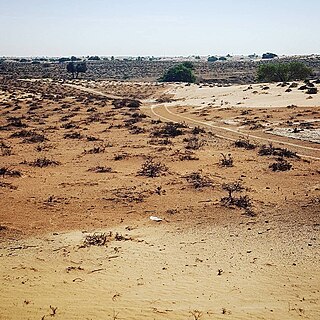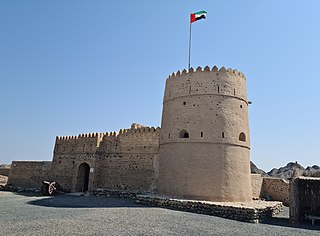Related Research Articles

Samad al-Shan is an archaeological site in the Sharqiyah province, Oman where Late Iron Age remains were first identified, hence the Samad Period or assemblage.

Uqair (Arabic:عقير) is an ancient fort of Islamic origin, located in the Eastern Province, Saudi Arabia. It is the first seaport in the Arabian Gulf. It is alternatively spelled Al-'Uqair, Uqayr, and Ogair, all Latin transliterations of the same Arabic word. It has been linked by some to the ancient city of Gerrha mentioned in Greek and Roman sources. The site was also the location of the conference at which the Uqair Protocol of 1922 was issued, which helped to establish the borders of modern Saudi Arabia.

Arabian Archaeology and Epigraphy or AAE is a scholarly journal for articles relating to the ancient Arabian Peninsula region.

Al Hayl is a suburb of Fujairah, United Arab Emirates (UAE), at the mouth of the Wadi Hayl. The old village in the Wadi Hayl is traditionally the home of the Kunud tribe.

Tell Abraq was an ancient Near Eastern city. Located on the border between Sharjah and Umm al-Qawain in the United Arab Emirates, the city was originally on the coastline of the Persian Gulf but changing sea levels have placed the remains of the city inland. It is located on the main road from Umm Al Qawain to Falaj Al Moalla.

Saruq Al Hadid is an archaeological site in Dubai, United Arab Emirates (UAE), and stands as one of the most important and enigmatic historical sites in the country. Findings from the site are displayed in a museum with the same name in the city of Dubai. The site was originally discovered by the ruler of Dubai, Sheikh Mohammed bin Rashid Al Maktoum, while flying his helicopter across the desert.

Bithnah is a village in Fujairah, United Arab Emirates (UAE), long occupying a strategic location in the Wadi Ham, which is the only natural link to the interior of the UAE and the Persian Gulf from the East Coast city, and Emirate of Fujairah.

Qaryat al-Saiḥ in Wadi Maḥram is an archaeological site in Samaʾīl Wilayat Sharqiyah, in Central Oman. This fortified village was inhabited in the Samad Late Iron Age and during Islamic times.

al-Akhḍar in Wadi Samad is an archaeological site in Mudhaibi Wilayat Sharqiyah, in Central Oman. This cemetery was inhabited from the Umm an-Nar to the Samad Late Iron Age and during Islamic times.

Ed-Dur or Ed-Dour is an Ancient Near Eastern City located in Umm Al Quwain, in the United Arab Emirates (UAE). One of the largest archaeological sites in the emirates, comprising an area of some 5 km2 (1.9 sq mi), the coastal settlement overlooks Al-Beidha Lake. One of the most important archaeological finds in the UAE, It has been dubbed 'one of the most significant lost cities of Arabia'.

Ṭīwī is a town in Oman. It is known for an archaeological site in the area known as al-Jurayf, in Ṣūr Wilayat Sharqiyah. The town and the site are located between Wadi Shab and Wadi Tiwi on the Gulf of Oman.

The Recent Pre-Islamic Period is an archaeological assemblage which is manifest in the few centuries around the year 0 in the lower Persian Gulf. It was discovered in the mid 1970s by Iraqi archaeologists. Some nine such sites are known at present especially ed-Dur in the Emirate Umm al-Qaiwain, and Mleiha in Sharjah in the Oman peninsula. Since the mid 1980s different teams studied especially these two sites, which are the largest in terms of surface area. They contain settlements, religious and industrial areas as well as cemeteries loosely scattered over a wide area. Mlayḥa forms an irregularly shaped surface of c. 4 km2. Two PIR sites have been identified in Central Oman, at Samāʾil/al-Bārūnī and at ʿAmlāʾ/al-Fuwaydah.
The archaeological site of Al-Ashoosh is a third-millennium BC settlement located 70km south of Dubai in the United Arab Emirates (UAE). It stands as a rare example of human occupation in the Rub' al Khali during the Umm al-Nar period. Archaeologists believe Al-Ashoosh was a seasonal settlement occupied by a hunter/pastoral community, probably occupying structures of perishable materials, during the second half of the third millennium BC. It is thought the water table would have been higher, supporting inland settlement in what is now a plain and arid site with a brackish well. The site was used for the production of stone tools.
Bahra 1 is an archaeological site in the Subiya region on the coast of Kuwait Bay (Kuwait) associated with the Ubaid culture. It is one of the earliest Ubaid culture settlements in the Persian Gulf region, about 5500–4900 BC.
Ricardo Francisco Eichmann is an Argentine-born German archaeologist. He was the director of the Orient Department of the German Archaeological Institute between 1996 and 2020 and previously a professor of Near Eastern archaeology at the University of Tübingen.

Wadi Hayl is a seasonal watercourse in the Hajar Mountains of Fujairah, in the United Arab Emirates. The wadi runs from the Fujairah industrial suburb of Al Hayl through the old village of Hayl and Hayl Fort, to reach the Wadi Helo.

Al Hayl Fort is located in the Wadi Hayl, to the West of Fujairah, in the United Arab Emirates. Constructed in 1932 by Sheikh Abdullah bin Hamdan Al Sharqi, the fort formed his principle residence for the following two decades. Consisting of a fortified courtyard house and an associated watchtower with commanding views to the East and West of Wadi Hayl, Al Hayl Fort overlooks the old village of Al Hayl, of which many buildings have now been restored. The village was abandoned in the late 1970s following the resettlement of its inhabitants to a new village further down the wadi, a seasonal watercourse, and protected by the Al Hayl Dam. The village was traditionally settled by members of the Kunud tribe, with evidence that the area has been settled since the Umm Al Nar period, with Umm Al Nar tombs and Iron Age petroglyphs both found in the area. A number of these are now being threatened by ongoing construction in the area.

Wadi Helo is a seasonal watercourse located in the Hajar Mountains of Sharjah, in the United Arab Emirates. The wadi runs northwest to southeast of the eponymous village of Wadi Helo, located on the Sharjah-Kalba highway.

Awhala Fort is a restored late Islamic Fort in the village of Awhala, in Fujairah, United Arab Emirates. The village is located in the lower reaches of the Wadi Helo. Significant finds of Iron Age development lie below the foundations of the fort and signs of Wadi Suq period occupation have also been found.

Bithnah Fort is a traditional double story rock, coral and mudbrick fortification located in the Wadi Ham, near the village of Bithnah in Fujairah, United Arab Emirates. The fort has played a significant role in the history of the Emirates, particularly in the emergence of Fujairah as an independent emirate in the early 20th century. With a controlling position overlooking the Wadi Ham, the fort replaced an Iron Age fortification.
References
- ↑ المطقة الشرقيةالتطور التاريخي موسوعة المملكة العربية السعودية
- ↑ Mouton, Michel (November 2009). "The settlement patterns of north-eastern and south-eastern Arabia in late antiquity". Arabian Archaeology and Epigraphy. 20 (2): 185–207. doi:10.1111/j.1600-0471.2009.00314.x. ISSN 0905-7196.
- ↑ Porter, Benjamin W.; Boutin, Alexis T. (2012-04-09). "The Dilmun Bioarchaeology Project: a first look at the Peter B. Cornwall Collection at the Phoebe A. Hearst Museum of Anthropology". Arabian Archaeology and Epigraphy. 23 (1): 35–49. doi:10.1111/j.1600-0471.2011.00347.x. ISSN 0905-7196.